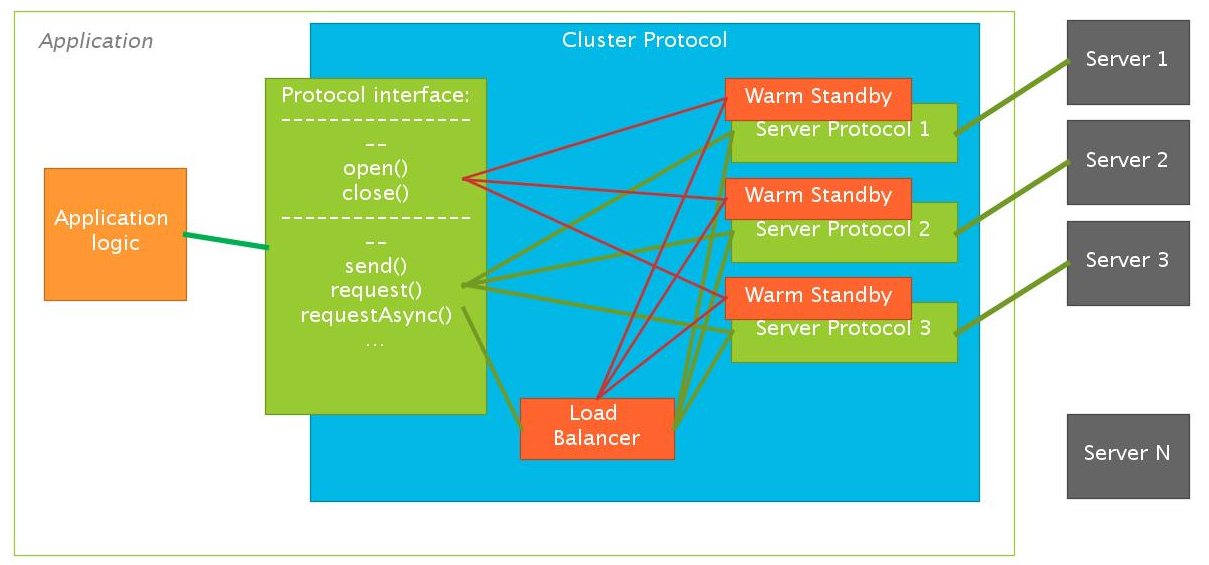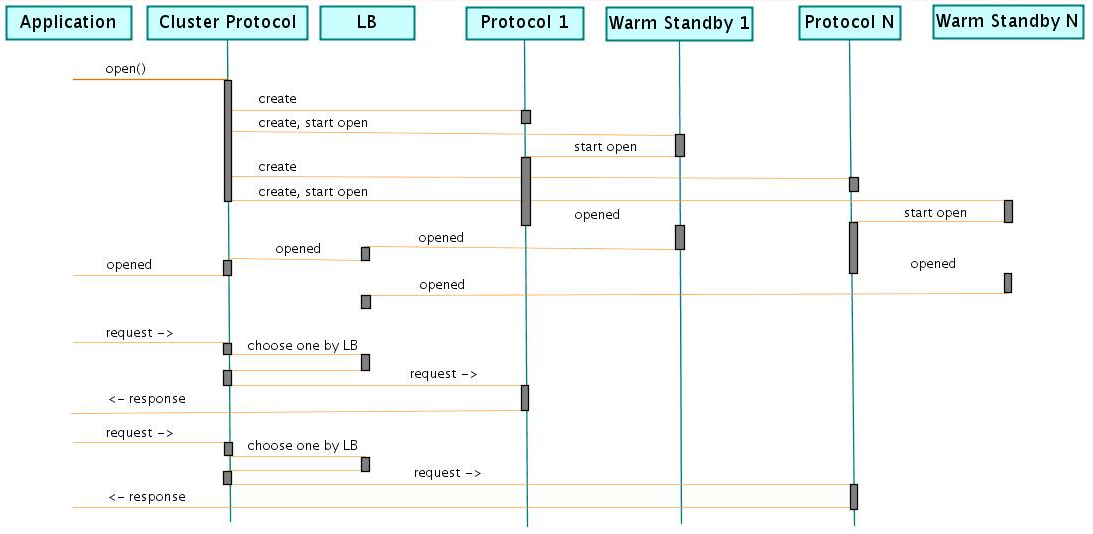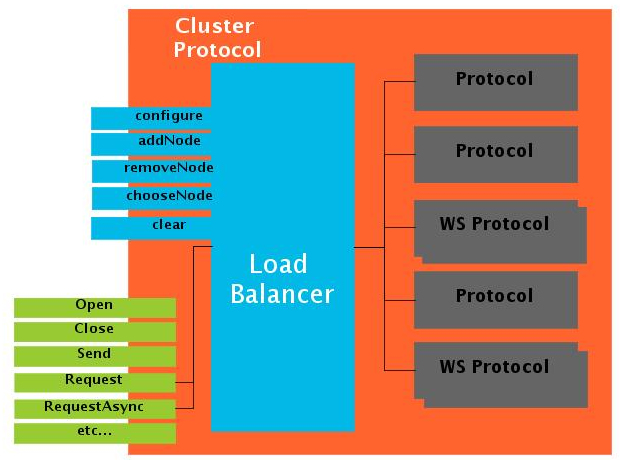Using the Cluster Protocol Application Block
This Application Block is designed to be used with applications where a large number of requests should be spread between a configured set of UCS servers - or other Genesys servers - in a cluster, providing a type of high-availability (HA) connection to that cluster.
Architecture Overview
One of the simplest and most common uses of the Platform SDK interface is a protocol that interacts directly with a Genesys server using a set of standard protocol methods (such as Open, Close, Send, Request).
To provide a single working protocol with at least one backup, we use the Warm Standby Application Block. That application block intercepts control of the protocol interface and provides switch-over between multiple protocols, or protocol restoration, using a single Warm Standby endpoint.
The Cluster Protocol builds on this idea, allowing you to work simultaneously with a series of protocols and Warm Standby application blocks (each of which can represent one or many individual protocols) the same way that you would with a single, standard protocol. To configure the Cluster Protocol, you use a mixed list of protocol and Warm Standby endpoints gathered from Configuration Server.
The Cluster Protocol itself covers any scenarios where we need simultaneous connections through a load balancer to many servers, where each server may have one or many backups.
Sequence Diagram: Main Scenario When Using Cluster Protocol Application Block
High Availability Options
The Cluster Protocol is able to control the state of protocol connections, and use the Warm Standby Application Block to keep them opened. Each cluster node may be initialized as a standard Platform SDK Endpoint, or using WSConfig (Warm Standby configuration) with one or more backup Endpoints added. A list of opened connections is tracked using a Load Balancer, which allows requests to be spread across connected protocols.
This gives your application the flexibility to configure one endpoint per connection ("server mode"), or to combine cluster endpoints in a single Warm Standby configuration and let the Cluster Protocol use a single connection to anyone of them ("client mode").
Load Balancing Options
The default Load Balancing strategy uses a "round robin" algorithm over connected servers for request forwarding. It is possible for you to create your own implementation of the Load Balancer interface, however, and provide it during creation of the Cluster Protocol instance.
Implementing a Custom LoadBalancer
final EspClusterProtocol haProtocol =
new EspClusterProtocolBuilder()
.withLoadBalancer(new MyLoadBalancer())
.build();
protected class MyLoadBalancer implements ClusterProtocolLoadBalancer {
@Override
public void configure(final ConnectionConfiguration config) {
}
@Override
public void addNode(final Protocol node) {
}
@Override
public void removeNode(final Protocol node) {
}
@Override
public Protocol chooseNode(final Message request) {
}
@Override
public void clear() {
}
}Disaster Recovery
Platform SDK does not inject any business functionality into connections, so the Cluster Protocol Application Block is able to provide disaster recovery by meeting the following requirements:
- High availability maintains a list of active connections to ensure that requests are not sent to disconnected servers.
- Any request that receives a ChannelClosedOnSendException or ChannelClosedOnRequestException response (because the connection was broken but not yet removed from the active list) is automatically resent to a different connection. Other exceptions are passed through to the client application to be handled manually.
There is no special configuration required to enable disaster recovery, but your application will need to include logic that handles generic IO exceptions or protocol timeout exceptions.
Sequence Diagram: Cluster Protocol with Node Connection Failure
Sequence Diagram: Cluster Protocol User Request Failure
How to Handle Lost Requests
It is possible for a communication error to occur where your application sends a request but the connection is broken before any response is received. When using the Cluster Protocol you may not know if another node in the cluster handled the request. In this scenario your application won't know if the server was able to receive or process the request correctly.
To address this, your application should include business logic that handles exceptions or null returns for a Cluster Protocol request and acts appropriately based on the type of request. For example, a request to read data can be sent again without impact, while a request that modifies data on the server may require your application to check the server state before retrying or providing notification that the request was successful.
Configuration Options
The Cluster Protocol Application Block supports configuration in Configuration Manager for the client application and cluster.
Client Connection Active Nodes Randomizer
The randomizer helper is a separate, additional component is available for working with cluster load balancing from client-type applications. This allows your applications to work with a cluster of servers without creating live connections to all of its nodes, and helps to prevent many stuck clients.
This component uses existing ClusterProtocol functionality to allow dynamic updates to node configuration. It then takes a whole list of cluster nodes and then performs periodical endpoint rotation. In deployments with a large number of clients, this could be critical for performance.
- Added nodes use a new instance of the usual Platform SDK protocol class, and asynchronous open will be started. The node is added to the load balancer immediately after it is connected.
- Removed nodes are immediately excluded from the load balancer, and scheduled for closing after the protocol timeout delay. This helps with delivery of responses on already started requests.
- The randomizer uses the Java Collections.shuffle(nodes) method to randomize the sequence of given nodes.
- To update protocol node configuration, this helper uses round-robin rotation over a randomly sorted, full list of cluster nodes, choosing a subset from a given number of elements. It allows the protocol to prevent all connections from breaking at a single moment, and to keep online during switchover.
- The randomizer component can also attach truncated node endpoints as backup endpoints for selected ones, allowing the internal WarmStandby service to quickly switchover from unresponsive nodes.
final UcsClusterProtocol ucsNProtocol = new UcsClusterProtocolBuilder().build();
List<WSConfig> nodes = ...;
// create nodes shuffler for 2 active connections
ClusterNodesShuffler shuffler = new ClusterNodesShuffler(ucsNProtocol, 2);
// let the shuffler to use truncated nodes endpoints as backup endpoints for the selected ones
shuffler.setUseBackups(true);
// initialize shuffler with the whole list of cluster nodes
shuffler.setNodes(nodes);
ucsNProtocol.open();
// schedule shuffling operation with 3 secs delay and 3 secs period
TimerActionTicket shufflerTimer = TimerFactory.getTimer().schedule(3000, 3000, shuffler);
// Do the business logic on the cluster protocol...
// In case of update in the cluster configuration, application should use 'shuffler.setNodes(newNodes)'
// instead of ClusterProtocol's methods related to nodes configuration.
// Shutdown:
shufflerTimer.cancel();
ucsNProtocol.close();Code Examples
Cluster Protocol Usage Example
UcsClusterProtocol ucsNProtocol =
new UcsClusterProtocolBuilder()
.build();
ucsNProtocol.setClientName("MyClientName");
ucsNProtocol.setClientApplicationType("MyAppType");
ucsNProtocol.setNodesEndpoints(
new Endpoint("ucs1", UCS_1_HOST, UCS_1_PORT),
new Endpoint("ucs2", UCS_2_HOST, UCS_2_PORT),
new Endpoint("ucs3", UCS_3_HOST, UCS_3_PORT));
ucsNProtocol.open();
EventGetVersion resp1 = (EventGetVersion) ucsNProtocol.request(RequestGetVersion.create());
EventGetVersion resp2 = (EventGetVersion) ucsNProtocol.request(RequestGetVersion.create());Client Nodes Randomizer Usage Example
Application code using the randomizer component may look like the following sample:
final List<WSConfig> nodes = ...;
final UcsClusterProtocol ucsNProtocol =
new UcsClusterProtocolBuilder()
.build();
ucsNProtocol.setTimeout(5000); // sets protocol timeout to 5 secs
ucsNProtocol.setClientName("MyClientName");
ucsNProtocol.setClientApplicationType("MyAppType");
ClusterNodesShuffler shuffler = new ClusterNodesShuffler(ucsNProtocol, 2); // creates nodes shuffler for 2 active connections
TimerActionTicket shufflerTimer = null;
try {
shuffler.setNodes(nodes); // - initializes shuffler with the whole list of cluster nodes.
ucsNProtocol.open();
shufflerTimer = TimerFactory.getTimer().schedule(3000, 3000, shuffler); // - schedules shuffling operation with 3 secs delay and 3 secs period
// do the business logic on the cluster protocol...
for (int i = 0; i < 200; i++) {
EventGetVersion resp = (EventGetVersion) ucsNProtocol.request(RequestGetVersion.create());
System.err.println("Resp from: " + resp.getEndpoint());
Thread.sleep(300);
}
} finally {
if (shufflerTimer != null) {
shufflerTimer.cancel();
shufflerTimer = null;
}
ucsNProtocol.close();
}Configuration Helper Example
The ClusterClientConfigurationHelper class is designed to make it easier for your application to make use of this Application Block by performing the following steps:
- Checks if client application is connected to cluster application
- If cluster application detected, then creates endpoints for all cluster connections of the specify type
- If cluster application not detected or no connections in cluster application found, then creates endpoints for all client application connections of the specify type (compatibility mode)
- If connected server has backup application, endpoint will have classical Primary\Backup configuration
- Supports specifying shared ADDP options, Transport and Application parameters in connection to cluster application. Those parameters can be overridden in connection to particular cluster node.
For more information, including an overview of the new Cluster Connection Configuration Helpers, see Using the Application Template Application Block.






